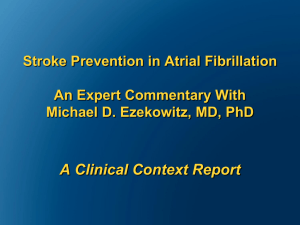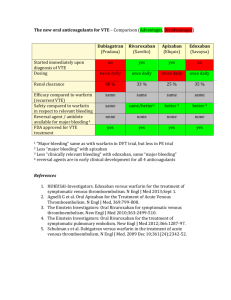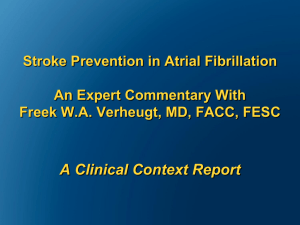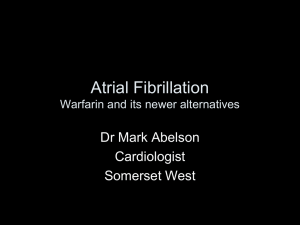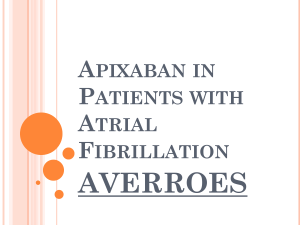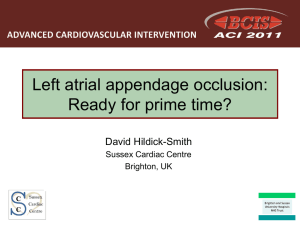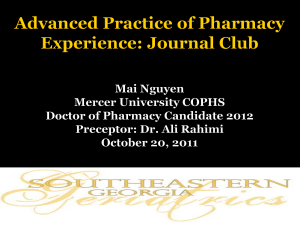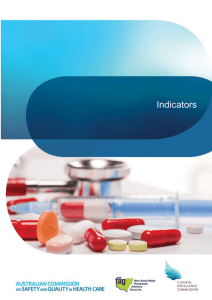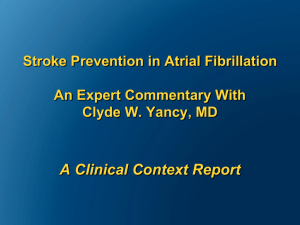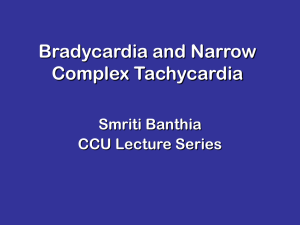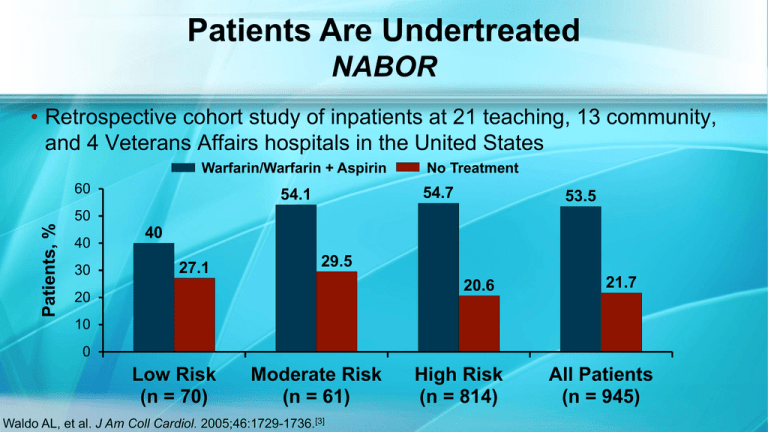
Patients Are Undertreated
NABOR
• Retrospective cohort study of inpatients at 21 teaching, 13 community,
and 4 Veterans Affairs hospitals in the United States
Warfarin/Warfarin + Aspirin
Patients, %
60
No Treatment
54.7
54.1
53.5
50
40
30
40
27.1
29.5
20.6
20
21.7
10
0
Low Risk
(n = 70)
Moderate Risk
(n = 61)
Waldo AL, et al. J Am Coll Cardiol. 2005;46:1729-1736.[3]
High Risk
(n = 814)
All Patients
(n = 945)
Patients Are Undertreated
Meta-analysis
• Patients with prior stroke/transient ischemic attack
– 25 of 29 studies reported undertreatment
– 21 of 29 studies reporting oral anticoagulant use < 60%
• Patients with CHADS2 ≥ 2
– 7 of 9 studies reporting treatment < 70%
Ogilvie IM, et al. Am J Med. 2010;123:638-645.[5]
AVERROES: Apixaban vs Aspirin
Primary Outcome
Apixaban Aspirin
Outcome
Annual
Rate
Apixaban vs Aspirin
Hazard Ratio
Annual
Rate
(95% Confidence Interval) P Value
Stroke or systemic
embolism
1.6
3.7
0.45 (0.32-0.62)
<.001
• Stroke
1.6
3.4
0.46 (0.33-0.65)
<.001
–
Ischemic
1.1
3.0
0.37 (0.25-0.55)
<.001
–
Hemorrhagic
0.2
0.3
0.67 (0.24-1.88)
.45
–
Disabling or fatal
1.0
2.3
0.43 (0.28-0.65)
<.001
0.1
0.4
0.15 (0.03-0.68)
.01
• Systemic embolism
Connolly SJ, et al. N Engl J Med. 2011;364:806-817.[7]
New Oral Anticoagulants
Stroke or System Embolic Event (vs Warfarin)
Risk Ratio (95% Confidence
Interval)
P Value
RE-LYa
Dabigatran 150 mg
b
ROCKET AF
Rivaroxaban
ARISTOTLEc
Apixaban
d
ENGAGE AF-TIMI 48
Edoxaban 60 mg
0.66 (0.53-0.82)
<.001
0.88 (0.75-1.03)
.12
0.79 (0.66-0.95)
.01
0.87 (0.73-1.04)
.08
a. Connolly SJ, et al. N Engl J Med. 2009;361:1139-1151[7]; b. Patel MR, et al. N Engl J Med. 2011;365:883-891[9]; c. Granger CB, et al.
N Engl J Med. 2011;365:981-992[10]; d. Giugliano RP, et al. N Engl J Med 2013;369:2093-2104.[11]
New Oral Anticoagulants (cont)
Stroke or Systemic Embolic Event (vs Warfarin)
Risk Ratio (95% Confidence Interval)
P Value
0.66 (0.53-0.82)
<.001
0.88 (0.75-1.03)
.12
0.79 (0.66-0.95)
.01
0.87 (0.73-1.04)
.08
Combined (Random)e
0.81 (0.73-0.91)
<.0001
Intracranial hemorrhage (Combined)e
0.48 (0.39-0.59)
<.0001
RE-LYa
Dabigatran 150 mg
ROCKET AFb
Rivaroxaban
ARISTOTLEc
Apixaban
ENGAGE AF-TIMI 48d
Edoxaban 60 mg
a. Connolly SJ, et al. N Engl J Med. 2009;361:1139-1151[7]; b. Patel MR, et al. N Engl J Med. 2011;365:883-891[9]; c. Granger CB, et al.
N Engl J Med. 2011;365:981-992[10]; d. Giugliano RP, et al. N Engl J Med 2013;369:2093-2104[11]; e. Ruff CT, et al. Lancet.
2014;383:955-962.[8]
Some Foods High in Vitamin K
• Kale
• Spinach
• Brussels sprouts
• Turnip greens
• Lettuce
• Broccoli
NIH website.[12]
• Endive
• Parsley
• Swiss chard
• Mustard greens
• Collards
Summary
• New oral anticoagulants reduced the risk for intracranial
hemorrhage compared with warfarin
• New oral anticoagulants have minimal food and drug
interactions
• Long-term adherence to this treatment is absolutely
necessary
• Clinicians should develop patient education strategies
• New oral anticoagulants do not require monitoring
Abbreviations
ACE = angiotensin-converting enzyme
AF = atrial fibrillation
ARISTOTLE = Apixaban for the Prevention of Stroke in Subjects With Atrial Fibrillation
AVERROES = Apixaban Versus Acetylsalicylic Acid to Prevent Stroke in Atrial Fibrillation Patients who have
Failed or are Unsuitable for Vitamin K Antagonist Treatment
CAD = coronary artery disease
CHA2DS2-VASc = congestive heart failure (or left ventricular systolic dysfunction), hypertension, age ≥75
years, diabetes mellitus, prior stroke or transient ischemic attack or thromboembolism, vascular disease,
age 65 to 74 years, and sex category (ie, female sex)
ENGAGE AF-TIMI 48 = Effective Anticoagulation with Factor Xa Next Generation in Atrial Fibrillation—
Thrombolysis in Myocardial Infarction 48
INR = international normalized ratio
NABOR = National Anticoagulation Benchmark and Outcomes Report
RE-LY = Randomized Evaluation of Long-Term Anticoagulant Therapy
ROCKET AF = Rivaroxaban Once-Daily, Oral, Direct Factor Xa Inhibition Compared With Vitamin K
Antagonism for Prevention of Stroke and Embolism Trial in Atrial Fibrillation
References
1. Hohnloser SH, Duray GZ, Baber U, Halperin JL. Prevention of stroke in patients with atrial fibrillation:
current strategies and future directions. Eur Heart J Suppl. 2008(Suppl H):H4-H10.
2. Granger CB. Newer oral anticoagulants should be used as first-line agents to prevent thromboembolism
in patients with atrial fibrillation and risk factors for stroke or thromboembolism. Circulation. 2012;125:159164.
3. Waldo AL, Becker RC, Tapson VF, Colgan KJ. Hospitalized patients with atrial fibrillation and a high risk
of stroke are not being provided with adequate anticoagulation. J Am Coll Cardiol. 2005;46:1729-1736.
4. Hylek EM, Evans-Molina C, Shea C, Henault LE, Regan S. Major hemorrhage and tolerability of warfarin
in the first year of therapy among elderly patients with atrial fibrillation. Circulation. 2007;115:2689-2696.
5. Ogilvie IM, Newton N, Welner SA, Cowell W, Lip GYH. Underuse of oral anticoagulants in atrial
fibrillation: A systematic review. Am J Med. 2010;123:638-645.
References (cont)
6. Warfarin drug interactions. http://www.drugs.com/drug-interactions/warfarin.html. Accessed November 5,
2014.
7. Connolly SJ, Ezekowitz MD, Yusuf S, et al; and the RE-LY Steering committee and Investigators.
Dabigatran versus warfarin in patients with atrial fibrillation. N Engl J Med. 2009;361:1139-1151.
8. Ruff CT, Giugliano RP, Braunwald E, et al. Comparison of the efficacy and safety of new oral
anticoagulants with warfarin in patients with atrial fibrillation: a meta-analysis of randomized trials. Lancet.
2014;383:955-962.
9. Patel MR, Mahaffey KW, Garg J, et al; for the ROCKET AF Investigators. Rivaroxaban versus warfarin in
nonvalvular atrial fibrillation. N Engl J Med. 2011;365;883-891.
10. Granger CB, Alexander JH, McMurray JJV, et al; for the ARISTOTLE Committees and Investigators.
Apixaban versus warfarin in patients with atrial fibrillation. N Engl J Med. 2011;365:981-992.
References (cont)
11. Giugliano RP, Ruff CT, Braunwald E, et al; ENGAGE AF-TIMI 48 Investigators. Edoxaban versus
warfarin in patients with atrial fibrillation. N Engl J Med 2013;369:2093-2104.
12. National Institutes of Health. Important information to know when you are taking Coumadin® and
Vitamin K. http://ods.od.nih.gov/pubs/factsheets/coumadin1.pdf. Accessed November 5, 2014.
13. Wanek MR, Horn ET, Elapavaluru S, Baroody SC, Sokos G. Safe use of hemodialysis for dabigatran
removal before cardiac surgery. Ann Pharmacotherapy. 2012;46:e21.

